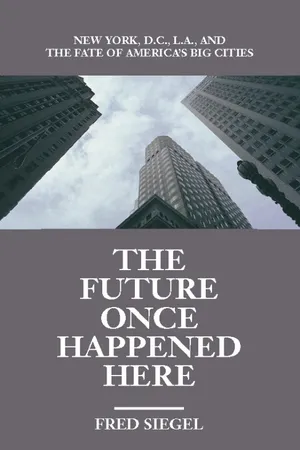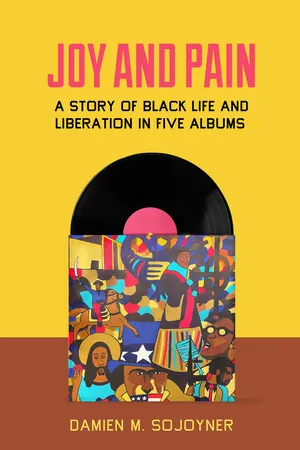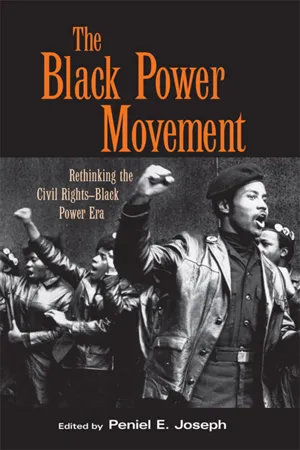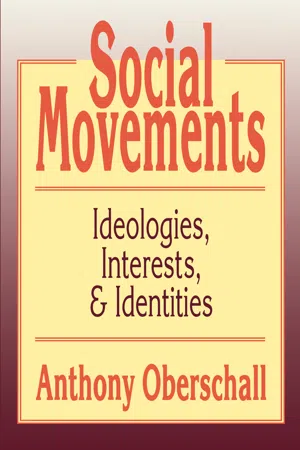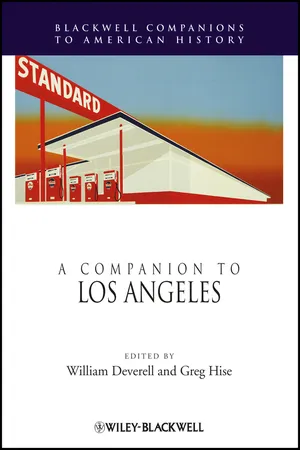History
Watts Riot
The Watts Riot was a six-day civil disturbance that took place in the Watts neighborhood of Los Angeles in August 1965. Sparked by tensions between the police and the African American community, the riot resulted in 34 deaths, over 1,000 injuries, and extensive property damage. It brought attention to issues of racial inequality and police brutality in the United States.
Written by Perlego with AI-assistance
Related key terms
6 Key excerpts on "Watts Riot"
- eBook - ePub
The Future Once Happened Here
New York, D. C., L. A., and the Fate of America's Big Cities
- Fred Siegel(Author)
- 2000(Publication Date)
- Encounter Books(Publisher)
In the early 1960s there were small riots in both the District of Columbia and Los Angeles. In 1964 there were larger, though still not major, riots in Harlem and Brooklyn; in Rochester, New York; in three New Jersey cities—Paterson, Jersey City, and Elizabeth; and in Chicago and Philadelphia. The most intense were in Harlem and Rochester. They broke out in an atmosphere of heightened expectations sixteen days after Lyndon Baines Johnson signed the 1964 Civil Rights Act. On the second day of the Harlem riot, a local militant, Jesse Gray, who had been leading a series of rent strikes, called for “a hundred skilled black revolutionaries” ready to die “participating in guerrilla warfare.” Gray’s call to arms came to little at the time. Given the upcoming presidential contest between Lyndon Johnson and Barry Goldwater, the 1964 riots were considered counterproductive even by many militants. Johnson’s landslide reelection and the 1965 riot in Watts changed all that.Watts was unlike any earlier riot. We are still living in its aftermath. Watts, the first major riot to be televised, inspired subsequent “rebellions” in Washington, D.C., Detroit, and Newark. The immediate damage to Los Angeles was obvious: thirty-four people, almost all black, were dead; whole blocks had been razed; and almost four thousand arrests had been made. Much of Watts was never rebuilt, and neither was the relative optimism regarding race and integration that had briefly held sway in the wake of the historic 1963 Civil Rights March on Washington.Many of the rioters, wrote civil rights strategist Bayard Rustin, viewed the uprising as a “manifesto,” an announcement that they were a force to be reckoned with. The Watts upheaval, said Sterling Tucker of the D.C. Urban League, “symbolically unleashed centuries of pent-up animosity.” The politicized rioters spoke more of revenge than reform, spoke not of integration but of power. They sought not to liberalize America but to liberate themselves from America.The immediate response to Watts, which broke out five days after the signing of the 1965 Voting Rights Act, was to see it as the work of a small group of street toughs and criminals. The toughs were involved, but the breadth of the participation suggested something much more ominous. Los Angeles was a city with an expanding black middle class, a city that, according to a National Urban League survey, ranked first among major American cities in the quality of black life. Yet post-riot surveys showed that the rioters represented a cross section of black South Central Los Angeles. What had happened for blacks of all classes was that the surge in collective consciousness flowing out of the Southern civil rights struggle broke down barriers to the expression of the rage and hostility that had built up for so long. - eBook - ePub
Joy and Pain
A Story of Black Life and Liberation in Five Albums
- Damien M. Sojoyner(Author)
- 2022(Publication Date)
- University of California Press(Publisher)
• • •The overwhelming majority of teenagers whom I met not only did not have that connection to these schools, but in stark contrast, associated the legends and myths that pertained to these schools with particular forms of disdain and moments of intense pain. As a result, our job became a little more focused. We had to figure out: What happened? How and why did these sites, which were home to some of the most dynamic forms of organizing and cultural creative genius, become solely synonymous with violence and repression?WATTS 1965
In August of 1965, Los Angeles, California, was on fire. The cumulative effect of a racial regime bounded by codified housing segregation, employment discrimination, vicious white mob attacks, and a deplorable education system were the kindle. The fact that these structural impediments were held intact by the Los Angeles Police Department (LAPD) was the spark that set the city ablaze. Given the unfortunate misnomer “Watts Riots,” the scope and scale of the collective action by Black Angelenos was unprecedented for an urban metropole (Horne 1995). In the wake of the 1965 Watts Rebellion, there were several reports and treatises that sought to provide analysis of the causes and solutions. The McCone Commission, headed by former CIA director John A. McCone, an assembled body forged together by then governor Pat Brown, issued the most famous of these documents. While the report pointed out the most obvious ways in which the city was divided upon racial lines, it failed to address the demands made by Black Angelenos leading up to and during the Watts Rebellion. The report also framed the revolt in terms of a violent rage without direction rather than a collective action. However, the method of the Watts Rebellion demonstrated that it was well-thought-out and informed by a calculated logic of insurrection against forces deemed to be oppressive within Black communities throughout the city (Horne 1995).1The McCone Commission, in conjunction with several other state-sponsored reports, effectively reframed the narrative of 1965 and, significantly, ignored the structural forces that were at the root cause of Black anger. In very carefully crafted language, the state admitted to fundamental problems in Los Angeles, but laid the burden at the feet of state and federal bureaucratic administration. If policies related to housing, employment, and education could be reformed, the problems that triggered the Watts Rebellion would be resolved. Thus, while the state was seemingly taking responsibility for the events that unfolded in 1965, the objective was to shore up the fissures of the frayed racial regime through a reassertion of the state as the body that would be the barometer by which justice was determined. - eBook - ePub
The Black Power Movement
Rethinking the Civil Rights-Black Power Era
- Peniel E. Joseph(Author)
- 2013(Publication Date)
- Routledge(Publisher)
21 The Watts Riot often becomes a way for historians to introduce the racial struggle in the North through a declension narrative in which the movement loses its righteous drive and disintegrates amidst spontaneous violence, internecine struggles between militant groups like Us and the Black Panthers, intense government repression, and white backlash. Anti-civil rights backlash in the North is described largely as a reaction to the riots and the black militancy that develops in their wake.By portraying Watts as “a dense, squalid ghetto” where “residents went about the cathartic business of destroying their neighborhood” sharp contrasts are drawn between accomodationist middle-class leaders who are portrayed as “out of touch” with the black majority viewed as hard-edged ghetto dwellers who then become the foot soldiers of Black Power.22 The term “Watts” serves as a social demarcation of black South L.A—not simply the neighborhood called Watts where only 9 percent of the city's African Americans lived in 1960, but a culturally foreign black bantustan encompassing the entirety of poor black L.A.23 Gerald Horne asserts in his seminal study of the uprising, that one of the causes of the Watts rebellion was that “few took pride in or care of their community, and that became a root of many of its social problems.”24This portrayal of Black Power and political organizing in the urban North squares with a turn in the social sciences toward a theory of urban crisis. Numerous social scientists and historians have linked structural changes in the economy, black Northern migration and urban segregation with a decline of community institutions and the development of a pathological set of behaviors among an isolated and poor black community.25 The urban black poor are often portrayed as a socially disintegrated, postindustrial underclass too busy surviving and too alienated from mainstream culture to theorize and mobilize against their oppression.26 Rioting makes sense within this paradigm because it is the spontaneous and angry political action expected from an estranged class of people. Some scholars have suggested that blacks in L.A. were physically and psychically distanced from the civil rights movement and that, as a result, the riots “filled an ideological void in black L.A.”27 - eBook - ePub
Social Movements
Ideologies, Interest, and Identities
- Anthony Oberschall(Author)
- 2017(Publication Date)
- Routledge(Publisher)
62 No effort was made to hold an area after the police were forced out of it and to coordinate action designed to prevent its comeback. No barricades were thrown up. Single individuals sniped at police and firemen from different locations and on numerous occasions, but there was no attempt to create a more organized form of armed resistance. While the precipitating incident touched off a police riot, which soon thereafter widened into a riot during which the targets of aggression became other whites besides police, subsequent days and nights produced a repetition of the same sort of behavior over an ever-wider area and involving greater numbers of participants, but did not produce a change towards a more insurrectionary or revolutionary pattern of action.It is the magnitude of the Los Angeles riot, both in duration, participation, amount of damage and casualties, and the forces needed to control it, which led many to characterize it as more than just a riot. But aside from magnitude, the Los Angeles riot was structurally and behaviorally similar to the black riots in other cities during the summers of 1964, 1965 and 1966. The collective significance of these events, however, is that the civil rights gains made by the black movement in the last few years, which have benefited the southern blacks and middle-class blacks, have not altered the situation of the lower-class urban blacks outside of the South and have not removed the fundamental sources of grievances of a large proportion of the black population in the United States.I wish to thank Mr. Borden Olive for helpful comments and assistance in locating some of the data on which this account is based.Notes
1. - eBook - ePub
Cultures of Violence
Visual Arts and Political Violence
- Ruth Kinna, Gillian Whiteley(Authors)
- 2020(Publication Date)
- Routledge(Publisher)
8 He quotes de Gaulle’s televised speech of 7 June 1968, in which the French president also acknowledged that ‘this explosion was provoked by groups in revolt against modern consumer and technical society’ (Viénet, 2014: §8). Viénet notes that:The situationists had foreseen for years that the permanent incitement to accumulate the most diverse objects, in exchange for the insidious counterpart of money, would one day provoke the anger of masses abused and treated as consumption machines.(2014: §6)Indeed, the SI did foresee a build-up of mass dissatisfaction with consumer capitalism: not in France but in the United States. They took a keen interest in US race relations and civil unrest, imagining the Watts Rebellion as the first stage in a broader struggle, signs of which they saw in the 1964 student strike at University of Berkeley that was linked to both civil rights and the Vietnam War. They predicted that African Americans had the potential to ‘unmask the contradictions of the most advanced capitalist system’ (Situ-ationist International, 2006: 195). In the obituary of ‘the man who started the [Watts] riot’, the New York Times described the Watts Rebellion as the biggest insurrection by African Americans in the United States since the slave revolts (25 December 1986). The uprising in Watts was the catalyst for a series of riots across America (1965–67) that I refer to as the ‘long, hot summers’.9At first, it seemed obvious that the Watts ‘riots’ were ‘race riots’, as they were described as such in the Los Angeles Times. For example, on 13 August they reported that an eighteen-year-old girl admitted to throwing bricks and rocks at ‘anything white’ (Hillinger and Jones, 1965). The LA Times also reported on how the riots were perceived abroad. It was front-page news in several countries, including the UK and South Africa. On 15 August, under the headline ‘Reds Call L.A. Rioting Evidence of Race Bias’, they reported that the foreign communist press was taking the opportunity to highlight US discontent (Associated Press, 1965). The New China News Agency is reported to have said that the riot was evidence of ‘a general outburst of their (negroes) pent-up dissatisfaction’ – the brackets, we assume, were inserted by the LA Times - eBook - ePub
- William Deverell, Greg Hise(Authors)
- 2010(Publication Date)
- Wiley-Blackwell(Publisher)
Battleground Chicago (2004), which would consider how the riot literally pitted insurgent black radicals and white working-class suburbanites at each other's throats. Journalists have been more interested than historians in detailing the evolution of Chief Parker's LAPD as a "paramilitary organization whose efficiency was its pride and discipline its obsession" – an organization so commanding and independent that Ed Davis declined to run for mayor in the 1970s because he felt he had more power as LAPD chief – but no historian has yet plumbed the worldview of LAPD street cops, much less the informers and counter-subversives who filled the ranks of its aggressive intelligence division. (Domanick 1994: 183, 196; Cannon 1999: 582). The cop archive would have to be assembled – from the LAPD's own files, from interviews with former officers, from the cop fiction of their poet-laureate Joseph Wambaugh, among others, and from the cop dramas of the 1950s and 1960s – but the promise would be a synthetic Watts history which took the LAPD's iron hand not as a given but as an enigma to be unraveled. In the process, we might arrive at a new sense of the interplay between subur-banization and urbanization in postwar Los Angeles, and the clash of ide-ologies involved."A day for all vendettas"From the moment they erupted at the intersection of Florence and Normandie on April 29, 1992, the Rodney King riots were understood as Watts redux, and for good reason. Both events were sparked by the outrage surrounding a single arrest, and kindled by black Los Angeles'underlying sense that the LAPD acted like an occupying army in their neighborhoods. Rodney King was, like Marquette Frye, a young black man stopped for a traffic violation, whose arrest became a galling symbol of the use of exces-sive force. The LAPD helmed by Daryl Gates in 1992, like the LAPD helmed by William Parker in 1965, prided itself on its aggressive, high-tech methods and its independence from civilian control. Gates had been Parker's driver and had been groomed as his successor; under his leadership, the LAPD earned the prize for being, statistically, the most trigger-happy police force in the nation, responsible for killing civilians at a rate more than double that of the next most lethal police force (Dunne 1991a, 1991b). Its "Operation Hammer," a series of street sweeps intended to eradicate gang activity around the crack cocaine trade, was notorious for indiscriminately rousting black and Latino youths in the lead-up to the riot. By the time the program shut down, almost half of black male Angelenos between the ages of 21 and 24 were listed as gang members (Davis 1992; Cannon 1999: 17–18). (Not coincidentally, the genre of gangsta rap emerged out of this milieu, taking the criminalization of black Angeleno youth as a given; Kelley 1994; Boyd 1996; Quinn 2005.)
Learn about this page
Index pages curate the most relevant extracts from our library of academic textbooks. They’ve been created using an in-house natural language model (NLM), each adding context and meaning to key research topics.
